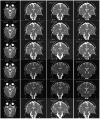Neurological Impact of SARS-CoV-2 Changing Variants: A 4-Year DW-MRI Study on Olfactory and Taste-Related Brain Regions
- PMID: 40243943
- PMCID: PMC11989964
- DOI: 10.3390/ijms26073164
Neurological Impact of SARS-CoV-2 Changing Variants: A 4-Year DW-MRI Study on Olfactory and Taste-Related Brain Regions
Abstract
Neurological symptoms such as impaired smell and taste have been recognized as hallmark manifestations of severe acute respiratory syndrome coronavirus (SARS-CoV-2) infection. This study investigates and quantifies microstructural changes in the white matter of the olfactory bulb and taste-related brain regions (frontal operculum, insular cortex and parietal operculum) using diffusion-weighted magnetic resonance imaging (DW-MRI). Apparent diffusion coefficient (ADC) values were measured in patients with confirmed coronavirus disease of 2019 (COVID-19) at the onset of anosmia and ageusia (24 patients, scanned between March and December 2020), 1 month post-infection (20 subjects) and 36 months post-infection (20 participants). ADC values were analyzed over time and compared to normal white matter ADC ranges (calculated retrospectively from 979 pre-pandemic patients) and to those from patients infected with the 2024 strain of SARS-CoV-2 (27 patients). The results revealed significantly elevated ADC values in the white matter of the targeted brain regions, with a peak at the time of infection, followed by a decline 1 month post-infection, and a return to near-normal levels 3 years later. In contrast, the 2024 COVID-19 variant demonstrated reduced virus-related alterations in brain microstructure compared to the 2020 strain. These findings highlight the potential of DWI as a non-invasive tool for elucidating the molecular mechanisms underlying olfactory and taste dysfunction in COVID-19 patients.
Keywords: COVID-19 neurological involvement; apparent diffusion coefficient; diffusion-weighted MRI; olfactory and gustatory dysfunction; white matter microstructural changes.
Conflict of interest statement
Author Nicoleta Iacob was employed by the company Miclaus Diagnostic Hub SRL. All authors declare that the research was conducted in the absence of any commercial or financial relationships that could be construed as a potential conflict of interest.
Figures


Similar articles
-
Olfactory bulb magnetic resonance imaging in SARS-CoV-2-induced anosmia in pediatric cases.Int J Pediatr Otorhinolaryngol. 2020 Dec;139:110469. doi: 10.1016/j.ijporl.2020.110469. Epub 2020 Oct 24. Int J Pediatr Otorhinolaryngol. 2020. PMID: 33120100 Free PMC article.
-
Olfactory Cleft Measurements and COVID-19-Related Anosmia.Otolaryngol Head Neck Surg. 2021 Jun;164(6):1337-1344. doi: 10.1177/0194599820965920. Epub 2020 Oct 13. Otolaryngol Head Neck Surg. 2021. PMID: 33045908 Free PMC article.
-
Brain diffusion alterations in patients with COVID-19 pathology and neurological manifestations.Neuroimage Clin. 2023;37:103338. doi: 10.1016/j.nicl.2023.103338. Epub 2023 Jan 28. Neuroimage Clin. 2023. PMID: 36731251 Free PMC article.
-
A Review of Neurological Involvement in Patients with SARS-CoV-2 Infection.Med Sci Monit. 2021 Jun 19;27:e932962. doi: 10.12659/MSM.932962. Med Sci Monit. 2021. PMID: 34145211 Free PMC article. Review.
-
The Prevalence of Olfactory and Gustatory Dysfunction in COVID-19 Patients: A Systematic Review and Meta-analysis.Otolaryngol Head Neck Surg. 2020 Jul;163(1):3-11. doi: 10.1177/0194599820926473. Epub 2020 May 5. Otolaryngol Head Neck Surg. 2020. PMID: 32369429
References
-
- Pierron D., Pereda-Loth V., Mantel M., Moranges M., Bignon E., Alva O., Kabous J., Heiske M., Pacalon J., David R., et al. Smell and taste changes are early indicators of the COVID-19 pandemic and political decision effectiveness. Nat. Commun. 2020;11:5152. doi: 10.1038/s41467-020-18963-y. - DOI - PMC - PubMed
-
- Nguyen H., Albayay J., Höchenberger R., Bhutani S., Boesveldt S., Busch N.A., Croijmans I., Cooper K.W., de Groot J.H.B., Farruggia M.C., et al. COVID-19 affects taste independent of taste–smell confusions: Results from a combined chemosensory home test and online survey from a large global cohort. Chem. Senses. 2023;48:bjad020. doi: 10.1093/chemse/bjad020. - DOI - PMC - PubMed
MeSH terms
Grants and funding
LinkOut - more resources
Full Text Sources
Medical
Miscellaneous

